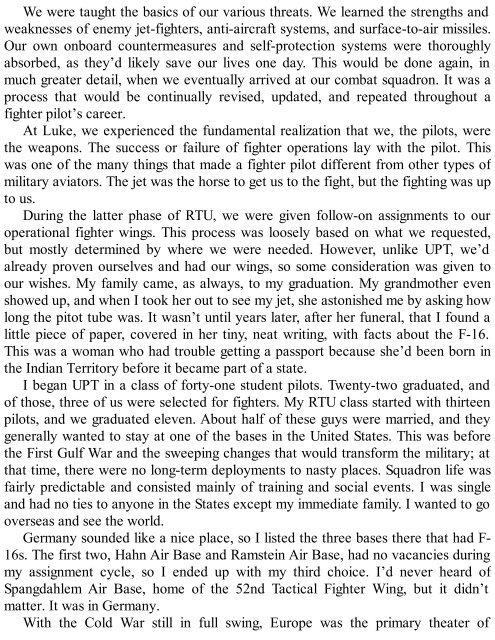You also want an ePaper? Increase the reach of your titles
YUMPU automatically turns print PDFs into web optimized ePapers that Google loves.
We were taught the basics of our various threats. We learned the strengths and<br />
weaknesses of enemy jet-fighters, anti-aircraft systems, and surface-to-air missiles.<br />
Our own onboard countermeasures and self-protection systems were thoroughly<br />
absorbed, as they’d likely save our lives one day. This would be done again, in<br />
much greater detail, when we eventually arrived at our combat squadron. It was a<br />
process that would be continually revised, updated, and repeated throughout a<br />
fighter pilot’s career.<br />
At Luke, we experienced the fundamental realization that we, the pilots, were<br />
the weapons. The success or failure of fighter operations lay with the pilot. This<br />
was one of the many things that made a fighter pilot different from other types of<br />
military aviators. The jet was the horse to get us to the fight, but the fighting was up<br />
to us.<br />
During the latter phase of RTU, we were given follow-on assignments to our<br />
operational fighter wings. This process was loosely based on what we requested,<br />
but mostly determined by where we were needed. However, unlike UPT, we’d<br />
already proven ourselves and had our wings, so some consideration was given to<br />
our wishes. My family came, as always, to my graduation. My grandmother even<br />
showed up, and when I took her out to see my jet, she astonished me by asking how<br />
long the pitot tube was. It wasn’t until years later, after her funeral, that I found a<br />
little piece of paper, covered in her tiny, neat writing, with facts about the F-16.<br />
This was a woman who had trouble getting a passport because she’d been born in<br />
the Indian Territory before it became part of a state.<br />
I began UPT in a class of forty-one student pilots. Twenty-two graduated, and<br />
of those, three of us were selected for fighters. My RTU class started with thirteen<br />
pilots, and we graduated eleven. About half of these guys were married, and they<br />
generally wanted to stay at one of the bases in the United States. This was before<br />
the First Gulf War and the sweeping changes that would transform the military; at<br />
that time, there were no long-term deployments to nasty places. Squadron life was<br />
fairly predictable and consisted mainly of training and social events. I was single<br />
and had no ties to anyone in the States except my immediate family. I wanted to go<br />
overseas and see the world.<br />
Germany sounded like a nice place, so I listed the three bases there that had F-<br />
16s. The first two, Hahn Air Base and Ramstein Air Base, had no vacancies during<br />
my assignment cycle, so I ended up with my third choice. I’d never heard of<br />
Spangdahlem Air Base, home of the 52nd Tactical Fighter Wing, but it didn’t<br />
matter. It was in Germany.<br />
With the Cold War still in full swing, Europe was the primary theater of
















